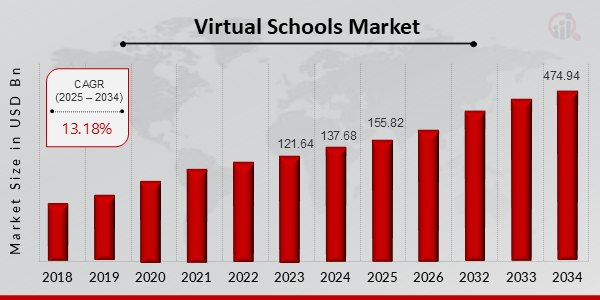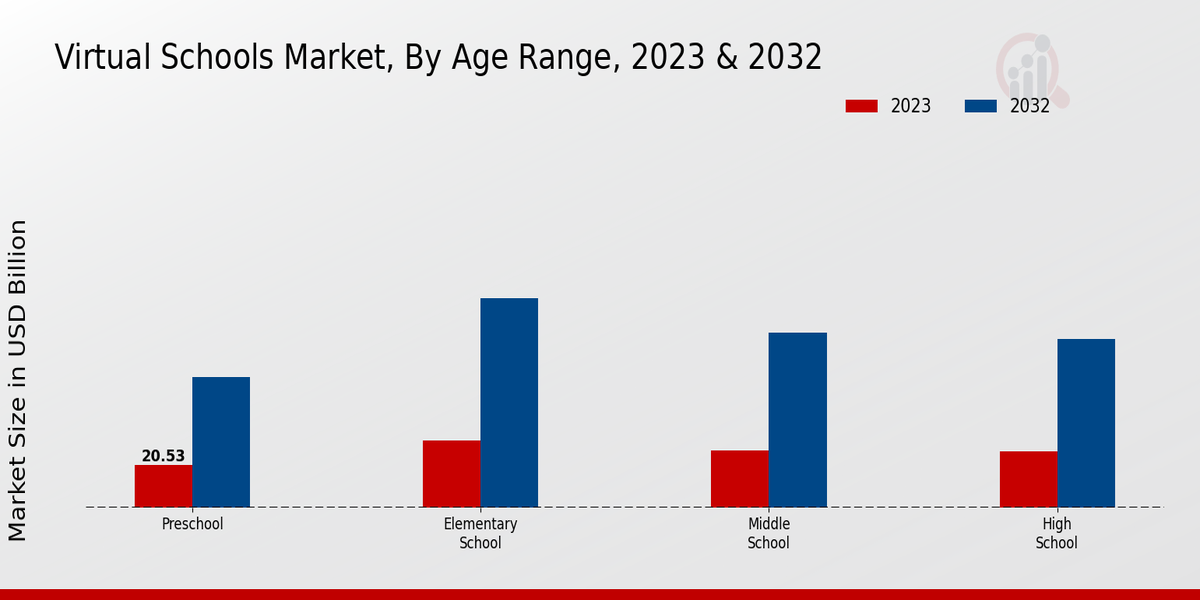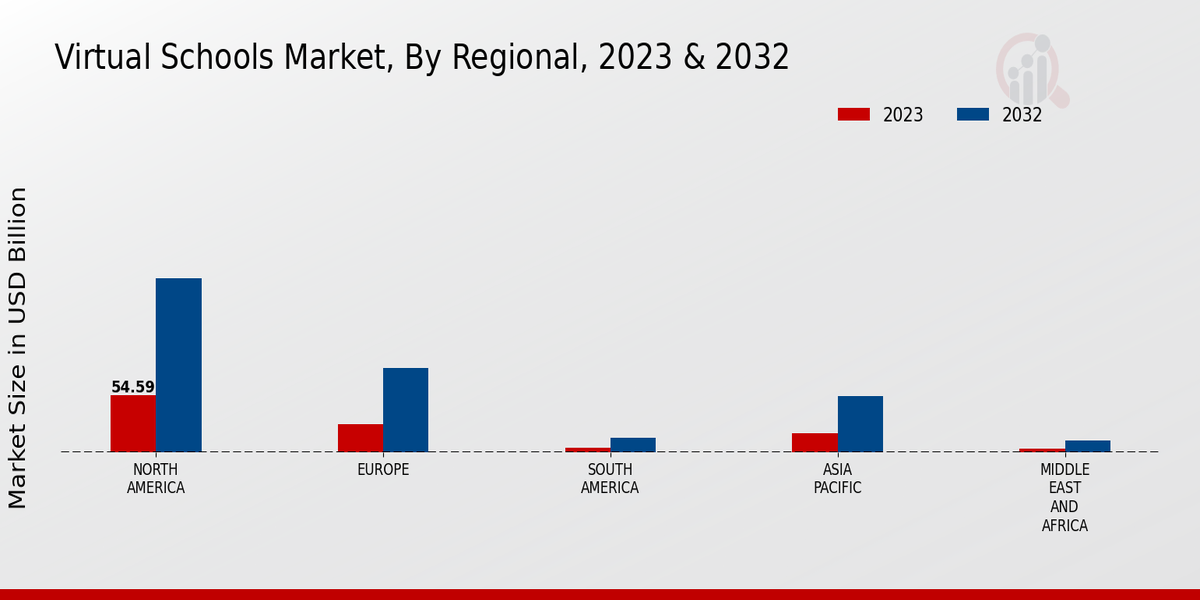Virtual Schools Market Overview
Virtual Schools Market is projected to grow from USD 155.82 Billion in 2025 to USD 474.94 Billion by 2034, exhibiting a compound annual growth rate (CAGR) of 13.18% during the forecast period (2025 - 2034). Additionally, the market size for Virtual Schools Market was valued at USD 137.68 billion in 2024.
Key Virtual Schools Market Trends Highlighted
The global virtual school market is experiencing significant growth due to advancements in technology, increasing internet penetration, and a growing demand for flexible and accessible education. Key market drivers include government initiatives promoting online learning, rising demand for personalized learning experiences, and the need for upskilling and reskilling in a rapidly evolving job market. Emerging trends in the virtual school market include the adoption of virtual reality (VR) and augmented reality (AR) for immersive learning, the integration of artificial intelligence (AI) for personalized learning pathways, and the rise of micro-credentialing and stackable degrees. These trends are creating opportunities for virtual schools to offer innovative and tailored learning solutions that meet the evolving needs of learners worldwide.
Figure 1: Virtual Schools Market, 2025 - 2034

Source: Primary Research, Secondary Research, MRFR Database and Analyst Review
Virtual Schools Market Drivers
Increasing Adoption of Online Learning
The COVID-19 pandemic has led to a significant increase in the adoption of online learning, as schools and universities were forced to close their physical campuses. This has created a new market opportunity for virtual schools, which offer a flexible and affordable way for students to continue their education. In addition, the growing popularity of online learning platforms, such as Coursera and Udemy, is making it easier for students to access high-quality educational content from anywhere in the world. This trend is expected to continue in the coming years, as more and more students realize the benefits of online learning.
Rising Demand for Personalized Learning
Traditional schools often struggle to provide personalized learning experiences for students, as they are constrained by factors such as class size and curriculum requirements. Virtual schools, on the other hand, offer a more flexible and individualized approach to learning. Students can learn at their own pace, choose the courses that interest them, and access additional support from teachers and mentors. This flexibility is particularly appealing to students who have unique learning needs or who want to pursue their education outside of the traditional school system.
Government Initiatives to Promote Virtual Education
Governments around the world are increasingly recognizing the potential of virtual schools to improve access to education and provide more flexible learning opportunities for students. As a result, many governments are investing in virtual education initiatives, such as providing funding for virtual schools and developing policies that support online learning. This support is expected to continue in the coming years as governments realize the benefits of virtual education for students, schools, and the economy as a whole.
Virtual Schools Market Segment Insights
Virtual Schools Market Age Range Insights
The global virtual school market is segmented by age range into Preschool, Elementary School, Middle School, and High School. The Elementary School segment is anticipated to lead the market throughout the period with a notable market share. There is an increasing deployment of virtual learning systems in elementary schools to maintain the interest of young learners and enhance their education performance, thereby facilitating the market dominance of this segment. Attributed to its leading position, the Elementary School segment was valued at USD 32.454 billion in 2023 and is projected to reach USD 100.368 billion by 2032 with a CAGR of 12.3%.
Furthermore, the rising use of virtual schools to provide convenient learning options is bolstering the socialization and skill development of children. The Preschool segment is also a significant contributor to the virtual school market revenue. The growth is attributed to the increasing awareness of the significance of early childhood education and the facility of learning from home. In 2023, this segment was valued at USD 20.534 billion and is projected to reach USD 62.463 billion in 2032 growing at a CAGR of 11.7%.
In similar ways, the Elementary School range, Middle School and High School segments are also witnessing steady market growth. The Middle School segment is estimated to be valued at USD 27.346 billion in 2023 and is projected to reach USD 83.684 billion in 2032 with a CAGR of 11.9%. The High School segment was valued at USD 27.145 billion by 2023 and is projected to reach USD 81.015 billion by 2032 growing at a CAGR of 11.8%. The growth is due to student shift in virtual schools for the convenience in schooling, specialized learning options, and diversity in course ranges. In conclusion, the Age Range Segmentation allocates the predominate requirements and desires made by the various groups of ages and stages of life in the market. This provides understanding toward the driving forces impeding growth trends of the market and helps market players target their products to growth tendencies.
Figure 2: Virtual Schools Market, By Condition, 2023 & 2032

Source: Primary Research, Secondary Research, MRFR Database and Analyst Review
Virtual Schools Market Curriculum Type Insights
The Curriculum Type segment is a key factor in the growth of the global virtual school market. In 2023, the Core Curriculum segment held the largest market share of 65%. This is due to the increasing demand for online education, particularly in developing countries. The Enrichment Programs segment is expected to grow at the fastest rate during the forecast period, with a CAGR of 15.5%. This growth is being driven by the increasing popularity of online enrichment programs, such as coding and robotics classes. The Special Education segment is also expected to grow at a significant rate, with a CAGR of 14.2%. This growth is being driven by the increasing demand for online special education services, such as speech therapy and occupational therapy. The Vocational Training segment is expected to grow at a moderate rate, with a CAGR of 12.8%. This growth is being driven by the increasing demand for online vocational training programs, such as those in healthcare and IT.
Virtual Schools Market Teaching Methodology Insights
The global virtual school market is segmented by Teaching Methodology into Synchronous Learning, Asynchronous Learning, Blended Learning, and Project-Based Learning. The Synchronous Learning segment held the largest market share in 2023, accounting for around 45% of the global virtual school market revenue. The Asynchronous Learning segment is expected to grow at the highest CAGR during the forecast period, owing to its flexibility and convenience. Blended Learning, which combines both synchronous and asynchronous learning, is also expected to gain traction during the forecast period. Project-Based Learning, which focuses on hands-on learning experiences, is expected to witness moderate growth during the forecast period.
Virtual Schools Market Accreditation Status Insights
The global virtual school market is segmented by Accreditation Status into Accredited, Non-Accredited, and In Process of Accreditation. Among these segments, the Accredited segment held the largest market share in 2023 and is projected to continue its dominance throughout the forecast period. The growth of this segment can be attributed to the increasing demand for quality education and the recognition of accredited virtual schools by governments and educational institutions. Moreover, accredited virtual schools offer a wider range of courses and programs, including core academic subjects, electives, and specializations, which makes them more attractive to students.
Virtual Schools Market Regional Insights
The regional segmentation of the global virtual school market offers valuable insights into the diverse market dynamics across different regions. North America leads the market with a significant share of 54.588 billion USD in 2023 and will reach 167.184 billion USD by 2032, driven by the high adoption of advanced technologies, the presence of established educational institutions, and government initiatives promoting virtual learning. Europe follows closely, benefiting from a strong education system and a growing demand for flexible learning options, with values of 26.572 billion USD in 2023 and 81.259 billion USD in 2032.
APAC is expected to witness substantial growth in the coming years, fueled by the rising middle class, increasing internet penetration, and government investments in education, with values of 18.091 billion USD in 2023 and 54.164 billion USD in 2032. South America and MEA have emerging markets with growing potential as they seek to bridge the gap in traditional education systems and provide access to quality education for all, with values of 4.431 billion USD in 2023 and 13.42 billion USD in 2032 for South America and 3.798 billion USD in 2023 and 11.503 billion USD in 2032 for the Middle East and Africa.
Figure 3: Virtual Schools Market, By Regional, 2023 & 2032

Source: Primary Research, Secondary Research, MRFR Database and Analyst Review
Virtual Schools Market Key Players and Competitive Insights
Major players in the virtual school market are focusing on expanding their operations and increasing their market share. They are also investing in research and development to create innovative new products and services. Leading virtual school market players are also forming partnerships and collaborations with other companies to expand their reach and gain access to new markets. The virtual school market is expected to grow significantly in the coming years, driven by the increasing demand for online education.
K12 Inc. is a leading provider of online education services. The company offers a variety of courses and programs for students in grades K-12. K12 Inc. also provides online teacher training and support. The company has a strong track record of success and has been recognized for its innovative approach to online education. EverFi is a leading provider of online educational games and simulations. The company's games and simulations are designed to teach students about a variety of topics, including financial literacy, health, and STEM. EverFi has partnered with over 200 school districts and has reached over 20 million students. Stride, Inc., formerly known as K12 Inc., is a leading provider of online education services. The company offers a variety of courses and programs for students in grades K-12. Stride, Inc. also provides online teacher training and support. The company has a strong track record of success and has been recognized for its innovative approach to online education.
Key Companies in the virtual school market Include
- K12
- Udemy
- LinkedIn Learning
- Khan Academy
- edX
- Pluralsight
- Pearson
- Codecademy
- Connections Academy
- Prodigy Education
- Carnegie Learning
- Udacity
- Stride
- Coursera
- Skillshare
Virtual Schools Market Developments
The growing adoption of online learning platforms, the increasing popularity of personalized learning experiences, and the rising demand for flexible education options are driving the market growth. Recent developments in the virtual school market include the launch of new virtual schools by established educational institutions, the expansion of existing virtual schools into new geographic regions, and the development of new technologies to enhance the virtual learning experience. For instance, in 2023, the University of California, Berkeley, launched its first fully online undergraduate degree program, offering a Bachelor of Arts in Data Science. Furthermore, in 2022, K12 Inc., a leading provider of virtual education programs, announced its expansion into the international market with the launch of its virtual school in Mexico.
Virtual Schools Market Segmentation Insights
- Virtual Schools Market Age Range Outlook
- Preschool
- Elementary School
- Middle School
- High School
- Virtual Schools Market Curriculum Type Outlook
- Core Curriculum
- Enrichment Programs
- Special Education
- Vocational Training
- Virtual Schools Market Teaching Methodology Outlook
- Synchronous Learning
- Asynchronous Learning
- Blended Learning
- Project-Based Learning
- Virtual Schools Market Accreditation Status Outlook
- Accredited
- Non-Accredited
- In Process of Accreditation
|
Report Attribute/Metric
|
Details
|
|
Market Size 2024
|
137.68 (USD Billion)
|
|
Market Size 2025
|
155.82 (USD Billion)
|
|
Market Size 2034
|
474.94 (USD Billion)
|
|
Compound Annual Growth Rate (CAGR)
|
13.18% (2025 - 2034)
|
|
Report Coverage
|
Revenue Forecast, Competitive Landscape, Growth Factors, and Trends
|
|
Base Year
|
2024
|
|
Market Forecast Period
|
2025 - 2034
|
|
Historical Data
|
2019 - 2023
|
|
Market Forecast Units
|
USD Billion
|
| Key Companies Profiled |
K12, Udemy, LinkedIn Learning, Khan Academy, edX, Pluralsight, Pearson, Codecademy, Connections Academy, Prodigy Education, Carnegie Learning, Udacity, Stride, Coursera, Skillshare |
| Segments Covered |
Age Range, Curriculum Type, Teaching Methodology, Accreditation Status, Regional |
| Key Market Opportunities |
Personalized Learning Access to Global Education Cost-effective Flexibility Expanded Educational Options |
| Key Market Dynamics |
Growing demand for online education Technological advancements Expansion into emerging markets Focus on personalized learning Rise of blended learning models |
| Countries Covered |
North America, Europe, APAC, South America, MEA |
Frequently Asked Questions (FAQ) :
The global virtual school market was valued at USD 121.64 Billion in 2023.
The global virtual school market is projected to reach USD 474.94 Billion by 2034.
The global virtual school market is anticipated to grow at a CAGR of 13.18% from 2025 to 2034.
North America is expected to dominate the global virtual school market throughout the forecast period.
The rising demand for flexible and personalized learning experiences, the increasing adoption of technology in education, and the growing number of students seeking online education are key factors driving the growth of the global virtual school market.
Virtual schools offer a wide range of applications, including K-12 education, higher education, corporate training, and continuing education.
Key competitors in the global virtual school market include K12 Inc., Pearson PLC, Stride, Inc., and Connections Education, among others.
The global virtual school market is estimated to reach USD 155.82 Billion by 2025.
The global virtual school market is projected to reach USD 474.94 Billion by 2034.
Key trends shaping the global virtual school market include the growing adoption of Artificial Intelligence (AI) and Machine Learning (ML), the increasing use of virtual and augmented reality (VR/AR) in education, and the rising demand for personalized learning experiences.

















